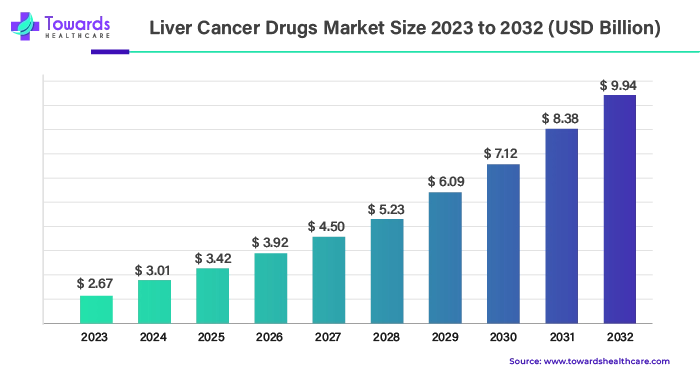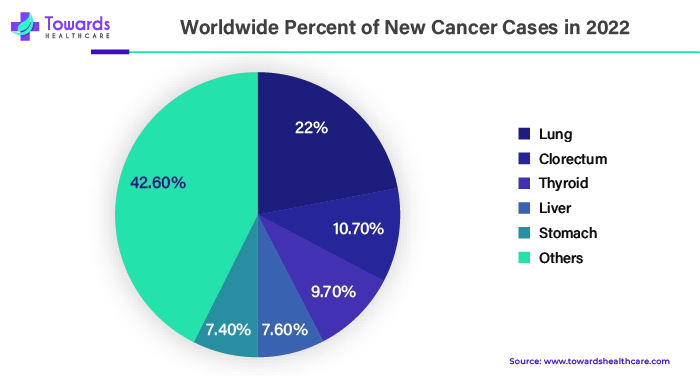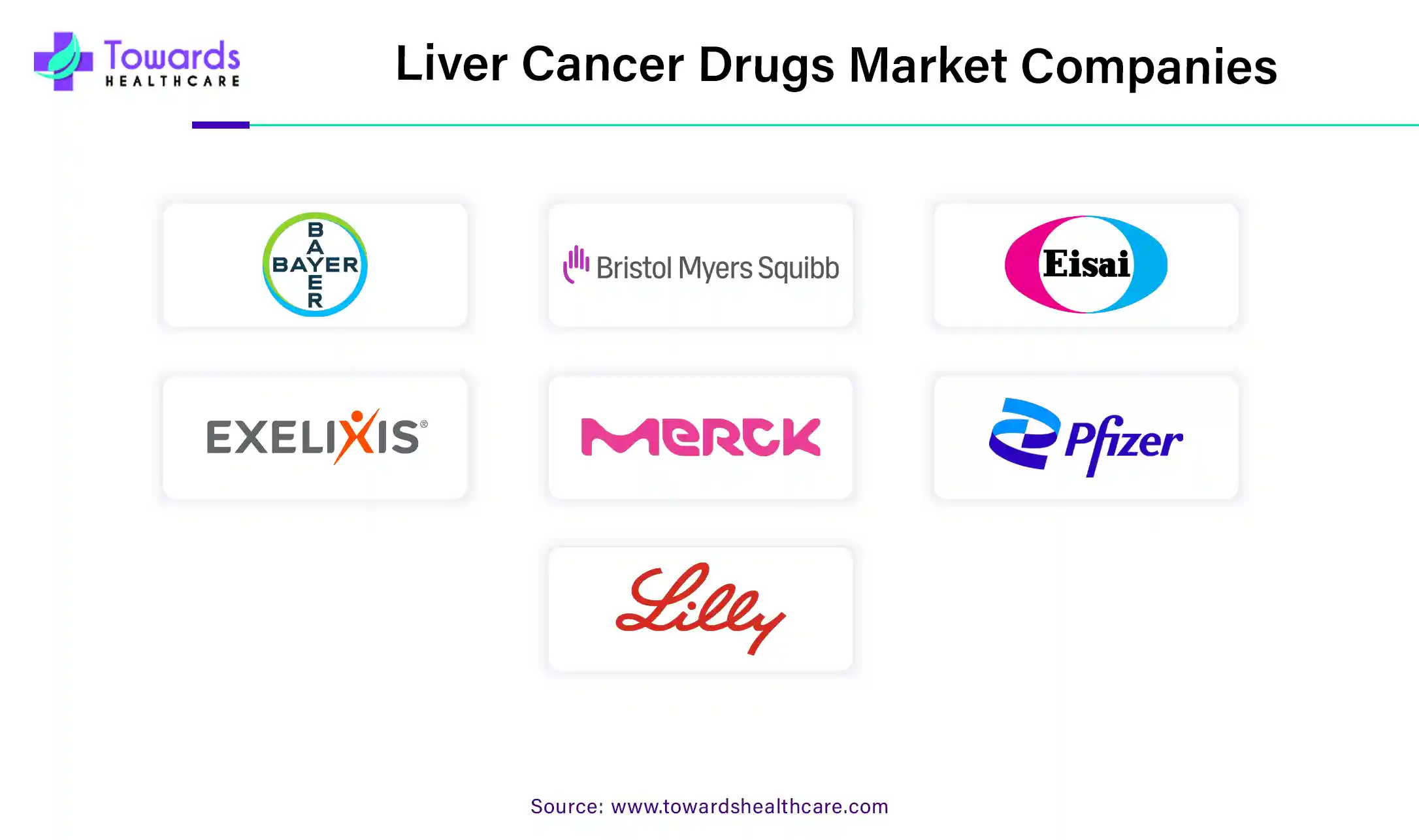April 2025

.webp)
Principal Consultant

Reviewed By
The liver cancer drugs market is expected to grow from USD 3.48 billion in 2025 to USD 11.5 billion by 2034, with a CAGR of 14.2% throughout the forecast period from 2025 to 2034.

With over 800,000 fatalities per year, liver cancer ranks as the fourth most common cause of death worldwide.
Public health authorities are extremely concerned about liver cancer because clinical cases are rising annually and the disease has a 30%–35% projected 5-year survival rate after diagnosis. The formation of malignant cells in the tissues of the liver is primary liver cancer. When cancer forms in other parts of the body and then is transferred to the liver is not primary liver cancer, instead, it can be considered metastatic cancer. Hepatocellular carcinoma is the most common form of liver cancer (approximately 90%) among others. Hepatoblastoma and intrahepatic carcinoma are some other types of liver cancers that are not very common. The cause of liver cancer is unknown but at times, chronic hepatitis infections can ultimately lead to liver cancer. Rising hepatitis B and hepatitis C can lead to an increased risk of developing liver cancer.
For instance,
Hepatitis B caused around 820000 deaths across the globe mostly due to hepatocellular carcinoma and liver cirrhosis (primary liver cancer). First-line treatment for advanced liver cancer involves a variety of medications and immunotherapy, while second-line treatment consists of chemotherapeutic medications derived from both natural and synthetic sources. First-line treatments include sorafenib and lenvatinib; second-line treatments include regorafenib and ramucirumab. The best course of treatment for liver cancer varies mostly on the stage at which the disease is progressing. Tyrosine kinase inhibitors (TKIs), among other second-line treatments, have been demonstrated in a large population of patients with uHCC, including those who have had immunotherapy, to prolong survival and improve outcomes while maintaining a stable safety profile. Surgical options include hepatectomy and liver transplantation, as well as ablation and radiation therapy.
Central Drug Research Institute, India conducted a collaborative study indicating that preventing this difficult disease may include focusing on the metabolic alterations that occur in cells.
Excess fat is produced in people with type 2 diabetes because their liver is unable to continuously regulate excessive blood sugar levels. Liver cancer is more likely to occur in those with nonalcoholic fatty liver disease.
Nonalcoholic Fatty Liver Disease (NAFLD) can cause irreversible hepatic inflammation and scarring, leading to cirrhosis. Liver damage and an increased risk of liver cancer are caused by type 2 diabetes, which initiates a series of complex health concerns. The risk of liver cancer is two to four times higher in those with type 2 diabetes than in people without diabetes.
Based on the February 2024 update, a readily measurable biophysical characteristic can be used to identify Type 2 diabetics who don't satisfy the existing screening standards but are at elevated risk of liver cancer, according to a Stanford Medicine study.
Over the past few years, several big players in cancer therapeutics have come into the picture for studying and developing new treatment approaches for liver cancers. Manufacturers are actively performing clinical trials on the combination therapies and developing advanced treatment options.
For instance,
With 90% of all instances ever reported, Hepatocellular Carcinoma (HCC) is the most common basic liver cancer. With a mere 3% 5-year survival rate, HCC ranks third in terms of cancer-related deaths. Patients have experienced clinical improvements in the advanced stages because of systemic therapy, but the prognosis is still quite bad. Novel molecular-targeted medicines have been created and clinically tested in the last few decades, with intriguing outcomes. Still, there is a pressing need for research into new medicines given the poor prognoses and limited advantages from current systemic therapy. Here comes the role of targeted and advanced therapies.

The prognosis is still quite miserable, but systemic therapy is the only ones that show any clinical effect in the latter stages. Therefore, to enhance the clinical results of patients with advanced HCC, new systemic treatment options must be developed. Novel molecular-targeted treatments have been created in the past few decades. More specifically, several small compounds that target Receptor Tyrosine Kinases (RTKs) have been tested in clinical settings.
| Sr. No. | Type of Therapy | Targeted Therapies |
| 1. | Tyrosine Kinase Inhibitors | Sorafenib |
| Lenvatinib | ||
| Cabozantinib | ||
| Regorafenib | ||
| 2. | VEGF Inhibitors | Bevacizumab + Atezolizumab |
| Ramucirumab | ||
| 3. | Other Targeted Agents | Donafenib |
| Nintedanib | ||
| Galunisertib | ||
| Galunisertib + Sorafenib |
Over the past 16 years, the treatment landscape of hepatocellular carcinoma has exhibited a significant transformation due to major advancements in targeted therapy. This growing journey can be attributed to several factors such as:
Patients with advanced HCC can now expect better treatment outcomes and a more optimistic prognosis because of these developments in targeted therapy.
BST02 is Biosyngen’s ( an immune-oncology company) immune therapy product that received the FDA’s Fast Track Development Grant in February 2024 for its clinical development to treat all types of liver cancer. BST02's developer, Biosyngen, is pushing the boundaries of cancer treatment development and approval by using the patient's immune system to fight cancer—a strategy that may even surpass more established TIL medicines. Adoptive immune cell treatment technique includes BST02, a T cell therapy that is based on the patient's own tumor infiltrating lymphocytes growing larger. It has the potential to treat liver cancer in all its forms, giving sufferers fresh hope. Compared to conventional TIL therapies, BST02 has many advantages, such as the capacity to get over geographic restrictions because of its cryopreserved form and the decreased requirement for large interleukin-2 dosages.
The incidence and prevalence of non-infectious diseases have sharply grown in recent decades, despite significant progress in their prevention and control. Liver cancer ranks second in terms of cancer-related deaths and is the sixth most frequent type of cancer in Asia. Approximately 609,596 new cases of liver cancer were reported in Asia in 2020, making up roughly 72.5% of the global liver cancer incidence.
There are regional differences as well; sub-Saharan Africa and East Asia have the greatest rates, although their underlying reasons are distinct. High-income nations have seen a decrease in liver cancer cases as a result of widespread viral hepatitis treatment and vaccination programs. On the other hand, there is a rise in low-income nations, which is frequently related to dangerous injection techniques and viral hepatitis.

By Drug Class
By Distribution Channel
By Geography
April 2025
March 2025
February 2025
February 2025